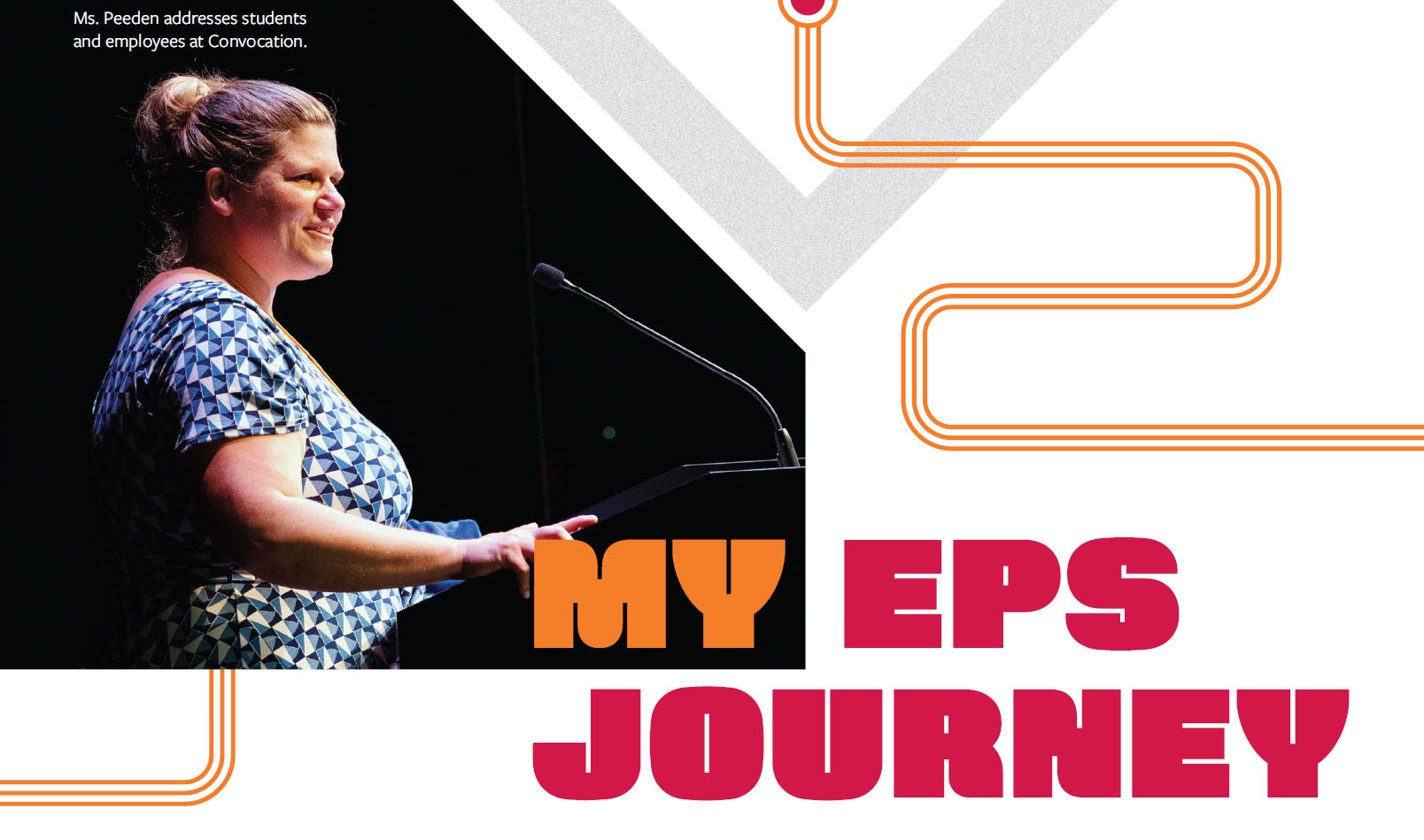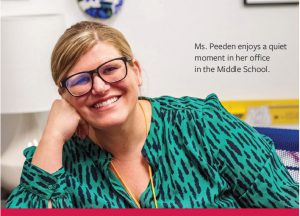
By Sarah Peeden, Head of Middle School
MY EASTSIDE PREP JOURNEY BEGAN IN EARLY 2021.
I had spent the last ten years at a school in southern California, and while my family and I were ready for a new adventure, I had some trepidations about leaving the school that I loved. But, after going through the interview process and eventually visiting the EPS campus twice in the spring of 2022 after accepting the position, I knew that I had found my new, albeit slightly rainier, home. Truthfully, it was an easy decision for two reasons—the people who make this community what it is and the mission that is infused into the lived experiences of the school.
THE COMMUNITY
When the school year started, I told new fifth- and sixth-grade students and families that, in many ways, we were in the same position. Like them, I was still learning to navigate the campus and its systems; I was still meeting people and trying to remember names. Even though our experiences were different, I could appreciate what it meant to be new at EPS. Luckily, that feeling of newness doesn’t seem to last for long here because of the nature of this community.
In those early weeks, faculty and staff checked in almost daily and families greeted me via email or called in to schedule casual in-person meetings to say hello. Now, at every event or activity I attend on campus, I am introduced and reintroduced to adult community members who not only want to talk about their children but also want to check in on my transition to EPS or to share insights about raising a family in the Pacific Northwest. Similarly, students went out of their way to introduce themselves and get to know me in those first weeks of school. Now, they regularly visit me to share highlights from their experiences in school, to talk through problems they may be facing with peers, or to just see how my day is going.
When I polled my fifth-grade Advisory to see if they were feeling the same outpouring of welcome in their early days at Eastside Prep, I was pleased to hear the same was true for them. They reported that, in addition to getting to know the campus and their teachers, older students would reach out to them and say hello. Within a month, they too were walking around campus like it was their second home.
 That’s the magic of this place; it is something that sets it apart. From ensuring nobody eats lunch alone to supporting one another in sports and art performances, EPS community members are invested in developing connections and supporting one another. Poet Gwendolyn Brooks astutely wrote, in her poem “Paul Robeson,” that as humans, “We are each other’s harvest; we are each other’s business; we are each other’s magnitude and bond.” Brooks’ words have long been my guiding star for developing, evaluating, and reimagining communities, especially in schools.
That’s the magic of this place; it is something that sets it apart. From ensuring nobody eats lunch alone to supporting one another in sports and art performances, EPS community members are invested in developing connections and supporting one another. Poet Gwendolyn Brooks astutely wrote, in her poem “Paul Robeson,” that as humans, “We are each other’s harvest; we are each other’s business; we are each other’s magnitude and bond.” Brooks’ words have long been my guiding star for developing, evaluating, and reimagining communities, especially in schools.
While no community may ever really reach the ideals set out in Brooks’ poem, every community can be sized up by its commitment to living and leaning in the direction of the commitments she sets out. At EPS, I see faculty with expertise in human development and SEL who are committed to helping students learn to navigate relationships in positive and pro-social ways; I see parents and faculty who know one another through conferences and events like Fall Harvest and who can effectively partner to support the growth and development of our students; and lastly, I see students who might not always make the right choices in terms of their interactions with peers but who are committed nonetheless to learning and growing from their mistakes as they become better stewards of the community and culture at EPS. In short, this is a community that cares and strives to support and better itself in both small and big ways.
THE MISSION
As with most organizations, every independent school has a mission statement. Mission statements define the values and objectives of an institution; they highlight commitments that stakeholders make through their work within an organization. Usually, mission statements in independent schools have two major prongs—academic excellence and some form of character development. Beyond those core components, schools articulate two to three other values that speak to their unique blend of pedagogy and purpose. I love to learn about schools and better understand what matters to their communities based on their mission statements. Before I came to Eastside Preparatory School, I spent time getting to know the school through its website and especially through its mission statement.
If you have ever spent time reading school mission statements, you might notice something that makes ours stand out—its concision. Four letters represent what it means to be an EPS Eagle: TALI. When I first read the mission, I was hit by the elegance of the language and what those four verbs and accompanying adverbs say. Not only is this school dedicated to educating students to think, act, lead, and innovate, but it is committed to doing so in a measured and thoughtful manner. In particular, I found myself mulling over the latter two tenets, “lead compassionately” and “innovate wisely,” long after I read the website and even after visiting the school. Anchoring leadership in compassion and innovation in wisdom indicated a level of purpose and care that resonated with me as a candidate. Those feelings have only deepened as I’ve come to see the ways that this community actively strives to live up to those words every day.
In a recent article from Harvard Business Review titled “What Does Your Company Really Stand For?”, organizational behavior researchers Paul Ingram and Yoonjin Choi explain that one of the greatest indicators of an organization’s success is tied to what they call “values alignment,” or the alignment of an organization’s stated mission with the values of its employees. Unlike “cultural fit,” a term derided for the way in which it has been used to gatekeep in organizations by decreasing diversity, “values alignment” attempts to acknowledge biases and frontload inclusion by building community with purpose through community input. When that alignment occurs
between individuals and organizations, exciting things happen. For example, Ingram and Choi write, “when [values alignment is] achieved, organizational values serve as a beacon to attract employees and can fuel collaboration and motivation. Those values remind employees of their best selves and improve their performance and well-being.” While these findings reflect on practices in the corporate world, they nevertheless provide insights for understanding other types of organizations—like schools.
At EPS, faculty and staff are committed to the school’s mission, and as a new member of this community, I see that commitment reflected in the innovative and enthusiastic approach that the other adults on campus take when they come to work each day. Adults here smile and laugh. They ask one another questions. They seek and give feedback. They take care of one another, all the while supporting the development of their students. In this moment when many educators are leaving the profession, EPS faculty and staff educators are dedicated to living and growing in service to the school’s mission, but it doesn’t stop there. It radiates into the student body. Beyond TALI rallies or mentions of “responsible action” in Scientific Thinking classes, students here similarly lean into the school’s values and are proud to do so. They care for one another and their education; they want to make “a better world” by embodying that TALI spirit. Ultimately, like the very nature of our school’s mission, this feeling of camaraderie and joy stands out, and while there are always areas for improvement and growth, there is so much to celebrate.
THE FUTURE
In the coming months, the school will develop a strategic plan that will dictate the major initiatives for growth to which the school and its community will commit for the next three to five years. Strategic plans create opportunities for reflection within the context of future improvement. As a new leader at EPS, I am excited to come onboard at this time, as this is a moment to remind ourselves who we are as a school as well as chart a path for where we want to go in the future. I am so happy to be here, in this moment of potential, with this incredible school, its community, and its mission.

